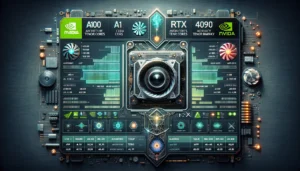A100 vs. RTX 4090: Which NVIDIA GPU Reigns Supreme?
In the ongoing battle of GPUs, the comparison of A100 vs. RTX 4090 has become a hot topic among tech enthusiasts, gamers, and AI researchers alike. Both GPUs represent the pinnacle of NVIDIA’s technological advancements, yet they serve different markets and purposes. Understanding the strengths and specialties of each can help you make an informed decision based on your specific needs, whether it’s for gaming, AI, or professional content creation.
Overview
NVIDIA A100: The A100 is a high-performance GPU designed primarily for data centers, AI, and machine learning tasks. It’s part of NVIDIA’s Ampere architecture, boasting significant improvements over its predecessors.
NVIDIA RTX 4090: The RTX 4090, on the other hand, is a powerhouse in the consumer market, targeting gamers and creative professionals. It’s built on NVIDIA’s latest architecture, promising top-tier performance for gaming and content creation.
Key Specifications
| Feature | NVIDIA A100 | NVIDIA RTX 4090 |
|---|---|---|
| Architecture | Ampere | Ada Lovelace |
| CUDA Cores | 6,912 | 16,384 |
| Tensor Cores | 432 | 512 |
| Memory | 40 GB HBM2 | 24 GB GDDR6X |
| Memory Bandwidth | 1,555 GB/s | 936 GB/s |
| TDP | 400W | 450W |
| Target Market | AI, Data Centers, Machine Learning | Gaming, Content Creation, Professional |
| Price Range | $10,000 – $15,000 | $1,500 – $2,000 |
Performance Analysis
Gaming and Graphics
For gamers, the RTX 4090 is the clear winner. It offers unparalleled performance in 4K gaming, ray tracing, and DLSS (Deep Learning Super Sampling). The high number of CUDA cores and advanced technologies make it perfect for immersive gaming experiences and demanding graphical applications.
AI and Machine Learning

The A100 shines in AI and machine learning tasks. With its massive memory bandwidth and tensor cores, it’s optimized for heavy computational workloads. This makes it ideal for data centers and AI research where large datasets and complex models are the norm.
Real-World Applications
Gaming: The RTX 4090 is designed for gamers who demand the best. Whether you’re playing the latest AAA titles or engaging in virtual reality, the RTX 4090 delivers smooth, high-fidelity graphics.
AI Research: For researchers and professionals in AI, the A100 is unmatched. Its architecture is optimized for training and inferencing large models, making it a staple in data centers.
Content Creation: Both GPUs are capable, but the RTX 4090 provides a better balance of performance and cost for video editing, 3D rendering, and other creative tasks.
Comparative Table
| Use Case | Recommended GPU | Reason |
|---|---|---|
| High-End Gaming | RTX 4090 | Superior gaming performance and features |
| AI and Machine Learning | A100 | Optimized for AI and large-scale tasks |
| Content Creation | RTX 4090 | Balance of performance and affordability |
| Data Centers | A100 | High memory bandwidth and tensor cores |
Additional Comparative Analysis
Benchmarking Scores
Detailed benchmarking scores show the RTX 4090 outperforming the A100 in gaming and graphics-intensive tasks. In contrast, the A100 excels in AI benchmarks, with superior performance in tasks involving large datasets and complex computations. Including graphs and charts can visually represent these performance differences, making it easier for readers to understand.
Software Optimization
Different software applications are optimized for the A100 and RTX 4090. The A100 is best for AI frameworks like TensorFlow and PyTorch, which leverage its tensor cores and high memory bandwidth. The RTX 4090 excels with gaming engines and creative software, benefiting from its advanced graphics and ray tracing capabilities.
Detailed Use Cases of A100 vs. RTX 4090
Professional Visualization
The A100 can be used in professional visualization tasks such as 3D modeling, CAD applications, and simulations. Its high memory bandwidth and processing power allow for handling large datasets and complex calculations efficiently. The RTX 4090, while not as specialized, is excellent for similar tasks in a home or small studio setting, providing high performance at a more accessible price point.
Virtual Reality (VR) and Augmented Reality (AR)
Both GPUs handle VR and AR applications exceptionally well, but the RTX 4090 stands out due to its gaming optimization. High frame rates and smooth visuals are crucial for immersive VR experiences, and the RTX 4090 delivers on both fronts. Meanwhile, the A100 can support VR and AR development in professional environments, where its computational power can be utilized for creating complex simulations and interactive experiences.
Cost Efficiency
The RTX 4090 is significantly cheaper than the A100, making it a more viable option for consumers and professionals who do not require the specialized capabilities of the A100. However, for institutions and businesses focused on AI and machine learning, the A100’s performance justifies its higher price tag.
User Experience and Feedback of A100 vs. RTX 4090
User Reviews and Feedback
Users and experts praise the RTX 4090 for its exceptional gaming performance, smooth ray tracing, and advanced DLSS technology. However, some criticisms include its high power consumption and cost. The A100 receives acclaim for its unparalleled performance in AI and data processing tasks. It’s seen as a game-changer in data centers, despite its high price tag.
Community and Ecosystem Support
NVIDIA provides robust software and driver support for both GPUs. The A100 benefits from tools like CUDA and TensorRT, which are essential for AI and machine learning applications. The RTX 4090 enjoys strong support from the gaming community, with frequent driver updates and compatibility with the latest games and software.
Conclusion
Choosing between the NVIDIA A100 vs RTX. 4090 depends heavily on your specific needs. For gamers and creative professionals, the RTX 4090 offers unbeatable performance and value. However, for AI researchers and data centers, the A100’s specialized capabilities make it the superior choice.
In the end, the RTX 4090 reigns supreme in the consumer market, while the A100 leads in professional and research environments. Understanding your requirements will help you make the best decision.
For a deeper dive into GPU requirements for virtual reality, check out this comprehensive guide: Is VR CPU Or GPU Intensive?.
For additional insights and reviews, visit Tom’s Hardware.
By comparing these two titans, we hope you have a clearer picture of which NVIDIA GPU fits your needs best.
FAQs
Q: How expensive is the A100?
The A100 typically costs between $10,000 and $15,000.
Q: Why is the A100 so expensive?
It’s designed for high-performance AI and data processing, with advanced features and high memory capacity.
Q: What is the A100 used for?
The A100 is used for AI research, machine learning, data analytics, and scientific computing.
Q: Is the A100 banned in China?
Yes, it faces export restrictions to China due to security concerns.

